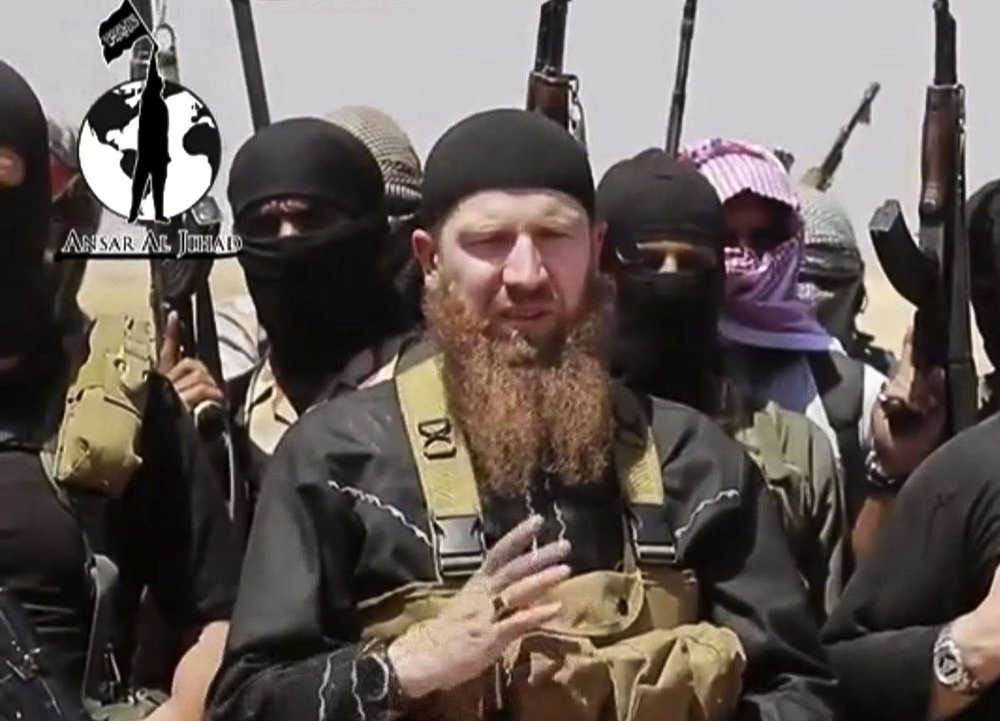BAGHDAD — Omar al-Shishani, a top Islamic State commander who was a magnet for fighters from the former Soviet Union, has died of wounds suffered in a U.S. airstrike in Syria, a senior Iraqi intelligence official and the head of a Syrian activist group said Tuesday.
Al-Shishani, who was wounded in a U.S. airstrike earlier this month, died on Monday evening outside the Islamic State group’s main stronghold of Raqqa in Syria, the two told The Associated Press. A U.S. military spokesman confirmed the reports.
The IS-affiliated Aamaq news agency cited an unnamed source as denying that al-Shishani was wounded or killed, without providing any evidence that he was still alive.
The red-bearded ethnic Chechen, who was in his 30s, was one of the most prominent IS commanders, appearing in several online videos leading fighters into battle. He served as the top commander in Syria before being appointed to lead three elite units that carried out special missions in Syria and Iraq, according to Hisham al-Hashimi, an Iraqi scholar who closely follows the group.
Al-Shishani, whose real name was Tarkhan Batirashvili, was an ethnic Chechen from the Georgia, a former Soviet nation in the Caucasus. He hailed from the Pankisi Valley, a center of the country’s Chechen community and a former militant stronghold.
He did military service in the Georgian army but was discharged after an unspecified illness, a former neighbor told The Associated Press in 2014. Georgian police later arrested him for illegal possession of arms, the neighbor said. Upon his release in 2010, Batirashvili left for Turkey.
He first surfaced in Syria in 2013 with his nom de guerre, which means “Omar the Chechen” in Arabic, leading an al-Qaida-inspired group called “The Army of Emigrants and Partisans,” which included a large number of fighters from the former Soviet Union.
Some 1,500 battle-hardened fighters from the Caucasus region joined IS because of al-Shishani, al-Hashimi said.
He first showed his battlefield prowess in August 2013, when his fighters proved pivotal in taking the Syrian military’s Managh air base in the north of the country. Rebels had been trying for months to take the base, but it fell soon after al-Shishani joined the battle, said an activist from the region, Abu al-Hassan Maraee.
In a video released in the summer of 2014, after IS swept across northern and western Iraq and declared an Islamic caliphate, al-Shishani stood next to the group’s spokesman and other fighters as they declared the elimination of the border between Iraq and Syria.
A U.S. airstrike targeted al-Shishani on March 4 near Syria’s eastern town of Shaddadeh, Pentagon Press Secretary Peter Cook said last week. Al-Shishani had been sent there to bolster IS fighters “following a series of strategic defeats,” Cook said in the statement.
Rami Abdurrahman, head of the Britain-based Syrian Observatory for Human Rights, said that after al-Shishani was wounded, IS “brought a number of doctors to treat him, but they were not able to.”
Abdurrahman, whose group monitors the conflict through a network of activists inside Syria, said al-Shishani died in a hospital in the suburbs of Raqqa. The Iraqi intelligence official, who spoke on condition of anonymity as he was not authorized to brief media, said the IS commander was buried in the eastern Syrian province of Deir el-Zour on Tuesday.
The Iraqi official said IS named an Iraqi to replace al-Shishani but did not give his name.
The spokesman for the U.S.-led coalition, U.S. Army Col. Steve Warren, said Tuesday that the coalition was able to “assess that he is dead” and that it “got the word Monday morning.”
Warren described al-Shishani as a “very important figure” in the Islamic State group, who was hit as part of a stepped-up campaign of U.S.-led airstrikes targeting IS leadership.
Al-Shishani was in the area of Shaddadeh “along with about a dozen other fighters who were in one spot … and we struck it,” Warren said last week.
Al-Hashimi said the U.S. decision to target top IS figures could have a major impact. “Maybe the death of al-Baghdadi will lead to a rapid collapse,” he said, referring to the top IS leader, Abu Bakr al-Baghdadi.
Iraqi officials said in November 2014 that al-Baghdadi was wounded in an airstrike. He has not been seen since then, but has released audio messages calling on his followers to step up attacks.
IS, which emerged from al-Qaida’s branch in Iraq, has many Iraqis among its top leaders. It exploited the chaos of Syria’s civil war to capture large areas in that country’s north and west before sweeping into Iraq in 2014. It has suffered setbacks since then, but still controls large parts of both countries, including Iraq’s second largest city, Mosul.
The U.N. has estimated that around 30,000 foreign fighters from 100 countries are actively working with the Islamic State, al-Qaida or other extremist groups.

